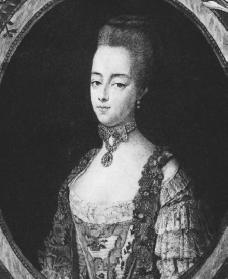Marie Antoinette Biography
Born: November 2, 1755
Vienna (now in Austria)
Died: October 16, 1793
Paris, France
French queen
M arie Antoinette was the queen of France at the outbreak of the French Revolution (1787–99). Her extravagant lifestyle, which included lavish parties and expensive clothes and jewelry, made her unpopular with most French citizens. When the king was overthrown, Marie Antoinette was put in jail and eventually beheaded.
A royal marriage
Marie Antoinette was born on November 2, 1755, in Vienna (now in Austria), the capital of the Holy Roman Empire. She was the eleventh daughter of the Holy Roman emperor Francis I (1708–1765) and the empress Maria Theresa (1717–1780). In 1770 she married Louis XVI (1754–1793). Louis was the French dauphin, or the oldest son of the king of France. He became king fours years later in 1774, which made Marie Antoinette the queen.
The personalities of the two rulers were very different. Louis XVI was withdrawn and emotionless. Marie Antoinette was happy and careless in her actions and choice of friends. At first the new queen was well liked by the French citizens. She organized elegant dances and gave many gifts and favors to her friends. However, people began to resent her increasingly extravagant ways. She soon became unpopular in the court and the country, annoying many of the nobles, including the King's brothers. She also bothered French aristocrats, or nobles, who were upset over a recent alliance with Austria. Austria was long viewed as France's enemy. Among the general French population she became the symbol for the extravagance of the royal family.
The queen intervenes
Marie Antoinette did not disrupt foreign affairs as frequently as has been claimed. When she first entered France she interrupted an official German greeting with, "Speak French, Monsieur. From now on I hear no language other than French." She sometimes tried, usually without great success, to obtain French support for her homeland.
The queen's influence on domestic policy before 1789 has also been exaggerated. Her interference in politics was usually in order to obtain jobs and money for her friends. It is true, however, that she usually opposed the efforts of reforming ministers such as A. R. J. Turgot (1727–1781) and became involved in court scandals against them. Activities such as the "diamond necklace affair," where the queen was accused of having an improper relationship with a wealthy church official in exchange for an expensive necklace, increased her unpopularity and led to a stream of pamphlets and articles against her. The fact that after the birth of her children Marie Antoinette's way of life became more restrained did not alter the popular image of an immoral and extravagant woman.
The last days of the monarchy
In the summer of 1788 France was having an economic crisis. Louis XVI yielded to pressure and assembled the Estates General, which was a governmental body that represented France's three Estates—the nobles, the church, and the French common people. Marie Antoinette agreed to the return of Jacques Necker (1732–1804) as chief minister and to granting the Third Estate, which represented the commoners, as many representatives as the other two Estates combined. However, after such events as the taking of the Bastille on July 14, 1789 (French citizens overran a Paris prison and took the weapons stored there), Marie Antoinette supported the conservative court faction that insisted on keeping the royal family in power.
On October 1, 1789, the queen attended a banquet at Versailles, France, during which the French Revolution was attacked and insulted. A

Courtesy of the
The queen is dead
On August 13, 1792, Marie Antoinette began a captivity that was to end only with her death. She was jailed in various Parisian prisons. After a number of unsuccessful attempts to escape, Marie Antoinette appeared before the Revolutionary Tribunal. She was charged with aiding the enemy and inciting civil war within France. The tribunal found her guilty and condemned her to death. On October 16, 1793, she went to the guillotine. (The guillotine was a machine used during the French Revolution to execute people by beheading them.) Marie Antoinette aroused sympathy by her dignity and courage in prison and before the executioner.
For More Information
Fraser, Antonia. Marie Antoinette: The Journey. New York: Doubleday, 2001.
Lever, Evelyne. Marie Antoinette: The Last Queen of France. New York: Farrar, Straus and Giroux, 2000.
Thomas, Chantal. The Wicked Queen: The Origins of the Myth of Marie-Antoinette. New York: Zone Books, 1999.
how did they live their lives after the death of their Mother and Father?
Catherine - She never said that. She had TONS of rumors flying around so you could never believe anything they said. Plus it was never proven true.
Hope this helps :)
(1.) Marie Therese, the Duchess of Angouleme
(2.) Louis Joseph, the Dauphin of France
(3.) Louis XVII
(4.) Princess Sophie
The last two children died. :(
1 - Marie Thérèse of France(1778-1851) who was the eldest biological daughter of Marie
2 - Louis Joseph, Dauphin of France(1781-1789)
3 - Louis XVII of France(1785-1795)
4 - Princess Sophie Hélène Béatrice of France(1786-1787)
Adopted are Below
5 - "Armand" Francois-Michel Gagné (c. 1771 – 1792), a poor orphan adopted in 1776
6 - Jean Amilcar (c. 1781 – 1793), a Senegalese slave boy given to the queen as a present by Chevalier de Boufflers in 1787, but whom she instead had freed, baptized, adopted and placed in a pension
7 - Ernestine Lambriquet (1778–1813), daughter of two servants at the palace, who was raised as the playmate of her daughter and whom she adopted after the death of her mother in 1788
8-10 - "Zoe" Jeanne Louise Victoire (born in 1787), who was adopted in 1790 along with her two older sisters when her parents, an usher and his wife in service of the king, had died